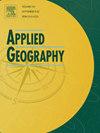成都郊区的识别与空间特征描述
IF 5.4
2区 地球科学
Q1 GEOGRAPHY
引用次数: 0
摘要
郊区作为城乡功能相互渗透的过渡地带,具有休闲、生态、农业、景观等多重价值。促进其良性发展是实现全球城乡可持续发展的关键。规划控制的基础是精确界定郊区的空间范围,科学认识郊区分异及其驱动力是提升重点规划水平的关键环节。然而,由于郊区的空间复杂性、边界模糊性和结构动态性等特点,目前对郊区的精细化定量识别研究较少。基于此,本文利用多源大数据和遥感信息技术,开发了郊区多维识别指标体系,采用随机森林模型和K-Medoids聚类算法,识别郊区分布及其细分类型,分析空间分异特征,并以成都市为例进行了实证研究。研究结果表明(1)成都市郊区大多集中在各区县中心城区周边的组团或带状区域,区县功能等级越高,郊区分布越密集。(2)成都市郊区的分布格局基本符合成都市规划的城市等级体系。 (3)城市型郊区、城郊互动型郊区和乡村型郊区在土地利用水平、经济发展水平和区域人口特征等方面各有特点。(4)区域开放度、政府行为、社会发展和地理区位是成都市郊区空间分异的核心驱动因素,城乡体系互动、社会资源流动和发展模式转变是影响郊区分异的空间图谱维度;(5)成都市可制定郊区单元的详细控规,规范和引导郊区的整体发展。为支持全球可持续发展目标,本研究提供了一种精确、公正地界定郊区的方法,有助于在全球范围内实施城乡一体化发展。本文章由计算机程序翻译,如有差异,请以英文原文为准。
Identification and Spatial Characterization of suburban areas in Chengdu
As transitional territories where urban and rural functions interpenetrate, suburban areas have multiple values such as recreation, ecology, agriculture and landscape. Promoting their benign development is the key to realizing global sustainable development of urban and rural areas. Planning control is based on precisely defining the spatial extent of suburban areas, and understanding suburban area differentiation and its driving forces scientifically is a key component in raising the bar for focused planning. However, there are currently few research on fine-scale quantitative identification of suburban regions because of their spatial complexity, ambiguous boundaries, and structural dynamic features. Based on this, this paper develops a multi-dimensional identification index system for suburban areas by using multi-source big data and remote sensing information technology, employs the random forest model and the K-Medoids clustering algorithm, identifies the distribution of suburban areas and their subdivided types, analyzes spatial differentiation characteristics, and conducts empirical research using Chengdu City as an example. The findings demonstrate that: (1) The majority of suburban areas in Chengdu City are concentrated in groups or belts surrounding the urban centers of various districts and counties, and the higher the functional class of a district or county, the denser the distribution of suburban areas. (2)The distribution pattern of suburban areas in Chengdu basically conforms to its planned urban hierarchy system.(3)Urban-oriented, suburban-interacted and rural-oriented suburban areas have their own characteristics in land use level, economic development and regional population characteristics.(4)Regional openness, government behavior, social development and geographical location are the core driving factors of spatial differentiation of suburban areas in Chengdu, and the interaction between urban and rural systems, the flow of social resources and the transformation of development models are the spatial mapping dimensions that affect its differentiation.(5)Chengdu can draw up detailed regulatory planning of suburban units to standardize and guide the overall development of suburban areas. In support of the global sustainable development goals, this study offers a methodology for precisely and impartially defining suburban areas, assisting in the implementation of integrated urban-rural development globally.
求助全文
通过发布文献求助,成功后即可免费获取论文全文。
去求助
来源期刊

Applied Geography
GEOGRAPHY-
CiteScore
8.00
自引率
2.00%
发文量
134
期刊介绍:
Applied Geography is a journal devoted to the publication of research which utilizes geographic approaches (human, physical, nature-society and GIScience) to resolve human problems that have a spatial dimension. These problems may be related to the assessment, management and allocation of the world physical and/or human resources. The underlying rationale of the journal is that only through a clear understanding of the relevant societal, physical, and coupled natural-humans systems can we resolve such problems. Papers are invited on any theme involving the application of geographical theory and methodology in the resolution of human problems.
 求助内容:
求助内容: 应助结果提醒方式:
应助结果提醒方式:


